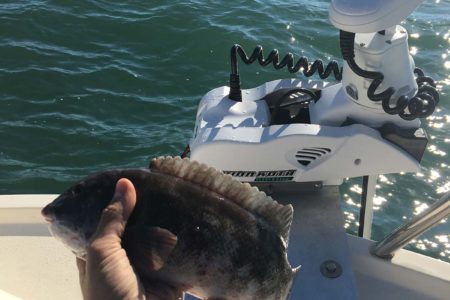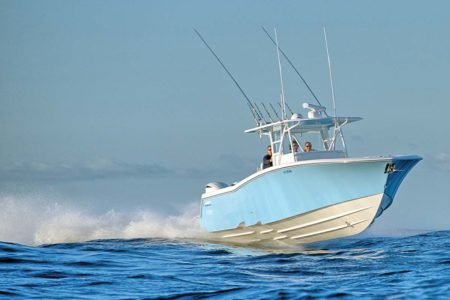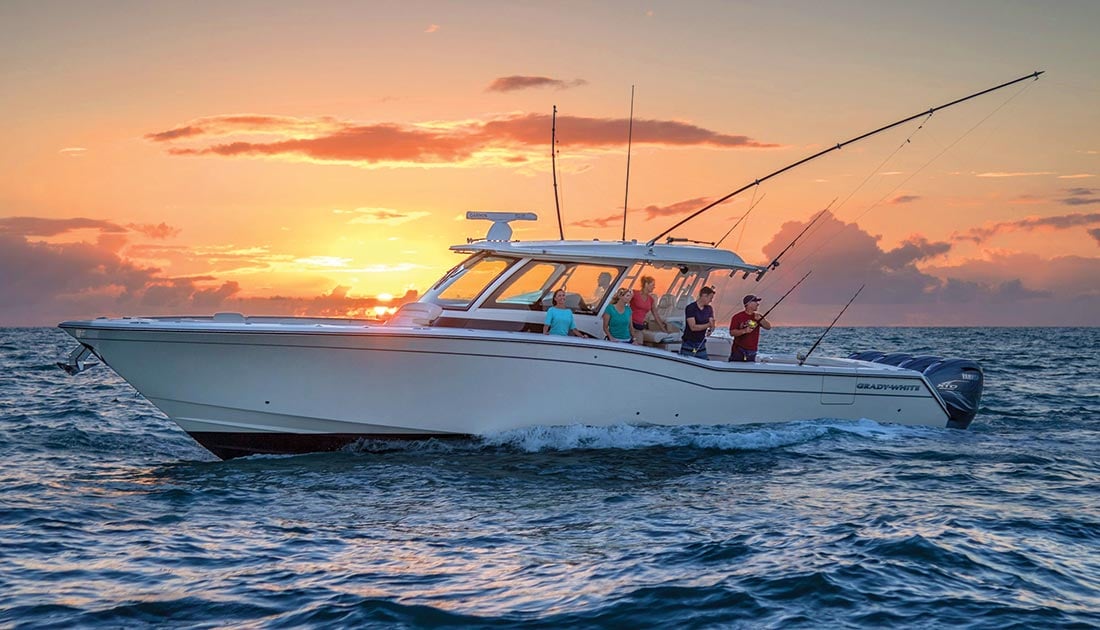
The one thing all of our fishing boats typically have in common is the reliance on some sort of 12-volt marine power cell to either start up the engine(s), run the electrical system, or both. This month’s focus is on 12V marine battery basics, along with some of the requisite accessories that are needed to make things happen onboard. Not all marine batteries are created equal. Prices for a standard group-24 series 12V power cell can range from $100 to $1,000 or more, depending on the battery type and technology. There are a trio of functional battery types, specifically, Starting, Deep-Cycle and Dual Purpose. Additionally, battery technology can be divided into four basic categories – flooded cell lead acid, absorbed glass mat (AGM), Gel, and Lithium/Iron.
Starting Batteries: Meant to give momentary high-power bursts to energize the starting motors on big marine outboards. They have a large number of thin plates designed for maximum surface area and maximum current output, which can easily be damaged by a deep discharge. Repeated deep discharges will result in capacity loss and ultimately in premature failure. Starting batteries kept on a continuous float charge will suffer corrosion of the electrodes which will also result in premature failure. Starting batteries should therefore be kept open circuit, but charged at least once every two weeks to prevent sulfation and a loss of capability. In flooded wet cell lead acid types, starting batteries are usually lighter in weight than deep cycle batteries of the same size, because the thinner and lighter cell plates do not extend all the way to the bottom of the battery case. This allows loose disintegrated material to fall off the plates and collect at the bottom of the cell, prolonging the service life of the battery. If this loose debris rises enough it may touch the bottom of the plates and cause failure of a cell, resulting in loss of battery voltage and capacity.
Deep Cycle Batteries: These are the heavyweights in your battery choice arsenal.
According to the engineers at Crown batteries, a deep cycle battery is designed to provide sustained power over a long period and run reliably until it is 80% discharged or more, at which point it needs to be recharged. It is important to note that although deep cycle batteries can be discharged up to 80% of their capacity, most manufacturers recommend not discharging below 50% to extend the life of the power cell. A starter battery discharges only a tiny percentage of its potential capacity (usually 2% to 5%) each time it is used. Deep cycle batteries provide sustained energy, making them ideal for marine house battery applications that require more than a quick start.
Dual Purpose (D/P) Batteries: These hybrid switch-hitters are meant to perform both starting and deep-cycle functions. They are extremely useful where you might only be able to have one battery onboard (never a great idea), or just want to have a pair of these dual-function power sources along for the ride as an insurance policy. As the name implies, D/P batteries usually feature higher marine cranking amps than a deep-cycle and significantly more cycling ability than a starter. It also has extra reserve power to run accessory loads and increased amp hour ratings compared to a starting battery. You can go the one starter/one deep cell and many Fisherman readers are in this boat. The problem is, if the deep cycle goes out in the middle of a fishing trip, running the electronics and pumps from the starting battery for any length of time might be a potential kiss of death.
Battery Technology
Flooded Cell Lead Acid: The flooded lead acid battery has been the #1 choice for boaters for decades, although that tide is slowly turning to some of the more exotic types that we will describe later. According to the techs at Battery University, “lead acid batteries are dependable and inexpensive on a cost-per-watt base. There are few other batteries that deliver bulk power as cheaply as lead acid and this makes the battery cost-effective for marine use. These batteries are often known as lead-antimony and lead-calcium. Lead acid is heavy and is less durable than lithium-based systems when deep cycled. A full discharge causes strain and each discharge/charge cycle permanently robs the battery of a small amount of capacity. This loss is small while the battery is in good operating condition, but the fading increases once the performance drops to half capacity. This wearing down applies to all batteries in various degrees. Depending on the depth of discharge, lead acid for deep-cycle applications provides 200 to 300 discharge/charge cycles. The aging is accelerated at elevated operating temperatures and when drawing high discharge currents.
Absorbed Glass Mat (AGM): These batteries are a type of Valve Regulated Lead Acid (VRLA) battery that use a material manufactured from very fine glass fibers. According to the folks that manufacture Deka Marine Batteries, the advantages of AGM types versus flooded lead acid batteries include up to twice the effective life cycle and significantly more vibration resistance for wave pounding protection. They also allow for safer installations with a sealed no-spill design to prevent leaking acid, higher freeze-resistance for improved cold weather performance, plus a lower discharge rate/loss of capacity during periods of infrequent use.
Flat plate AGM batteries have six sets of plates with glass mat separator containing the electrolyte arranged in a straight line inside the battery. Because the plates are compressed in rows, the battery has more capacity. Plate compression enables longer life or more total energy usage over time. Yet another spin on the AGM battery is spiral technology which results in more power in a smaller box and the ability to recharge much faster. The immobilized plates give you a battery that lasts longer and performs better throughout its life.
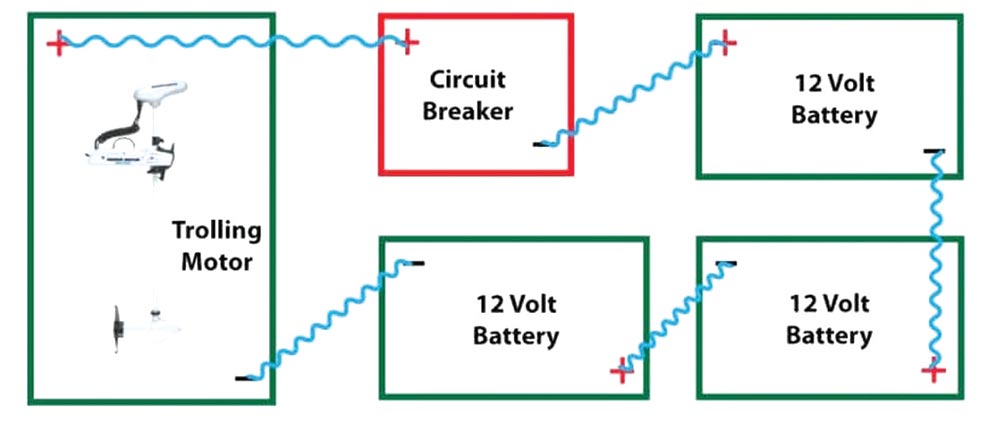
Gel: According to the engineers at Optima, a gel battery design is typically a modification of the standard lead-acid marine battery. A thickening agent (typically silica) is added to the electrolyte to reduce movement and flow inside the battery case, creating a thixotropic gel that permanently locks in the electrolyte into this matrix. Gel batteries are typically sealed, spill-proof and maintenance-free. Because it uses gelled electrolyte, there is no need to check fluid levels. Gel marine batteries also hold onto their internal charge better than most of the other lead-acid types with a self-discharge rate that’s typically only 2% to 3% per month, so if it’s been a long time between fishing trips, the gel marine battery gives you additional peace of mind.
Lithium Ion: A relative newcomer compared to the three aforementioned lead-acid types of marine power cells, Lithium Iron Phosphate (aka lithium ion) batteries offer a number of advantages of lead cell marine power cells, among them being:
Lithium batteries deliver higher power during cranking and hold a higher voltage during discharge than a comparably sized lead acid battery. Lithium batteries are also lighter. Some 24-series deep-cycle AGM or Gel batteries can weigh over 60 pounds while a 24-series lithium battery tips the scale at about 23 pounds. Lithium-ion batteries accept charge current up to five times faster than lead-acid batteries.
Lithium-ion marine batteries will hold a higher amp rating longer compared to lead acid batteries, which is a great feature for electric trolling motor use. Better yet, you can swap a trio of 60-pound 12V deep cycle lead-acid batteries for a single 36-volt lithium that weighs in at only 30 pounds. The down side for lithium-ion batteries, is their cost, which can be prohibitive. Depending on the battery voltage (12-24-36) and the battery type (starting or deep-cycle), prices can start in the $700-$800 range and go into the thousands ($2,200-$2500).
Read the Label
The label on your marine battery is a wealth of data and usually will tell you everything you need to know about what type of power cell(s) you have aboard, along with their capability. I have included a photo of the label from one of my new Optima AGM (absorbed glass mat) 12V marine batteries as it is a great learning tool. The model number (D27M) signifies that it is a marine, 27-series, dual purpose battery. The MCA (marine cranking amps) rating is 1000 amps. The CCA (cold cranking amps) rating is 800 amps. The AH (amp hours) rating is 66 and the RC (reserve capacity rating) is 140 minutes for running a 25-amp load. A more complete definition of these ratings is as follows, courtesy of the Exide Corporation:
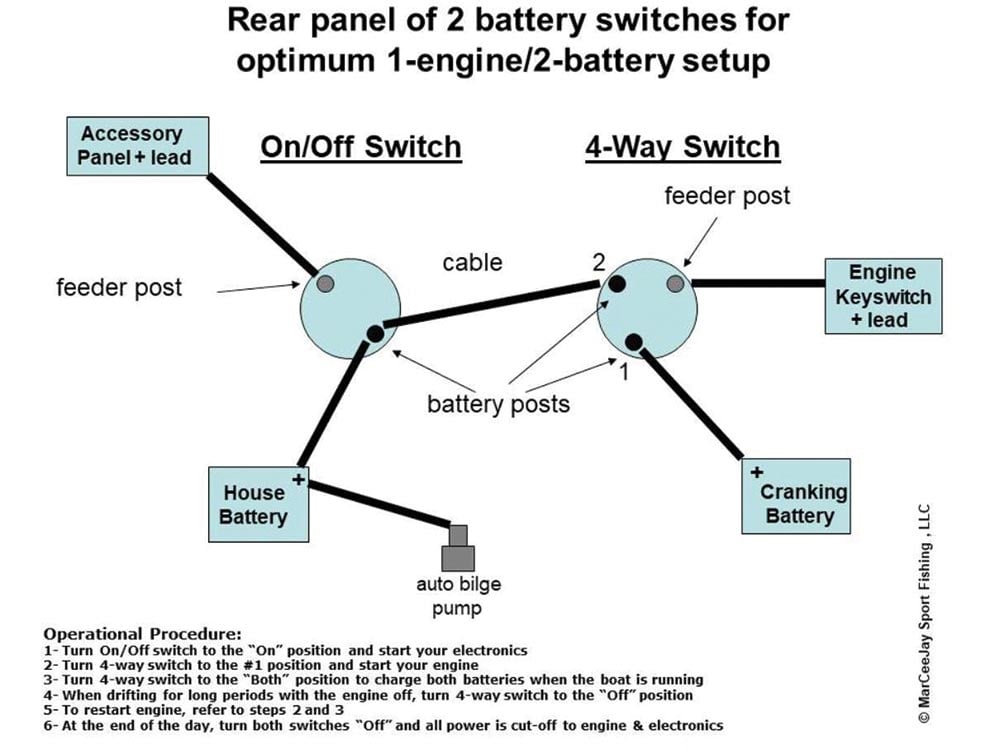
Marine Cranking Amps (MCA): The marine cranking amps rating refers to the number of amps that a lead-acid battery can deliver for 30 seconds at 32 degrees F (0 degrees C), while maintaining at least 7.2 volts (1.2 volts per cell).
Cold Cranking Amps (CCA): The cold crank rating refers to number of amperes (amps) a lead-acid battery can deliver for 30 seconds at 0 degrees F (-17.8 degrees C), while maintaining at least 7.2 volts (1.2 volts per cell).
Amp Hours (AH): The number of amp-hours which can be delivered under specified conditions as to temperature, rate of discharge and final voltage. A marine 12V battery with an AH rating of “66” can delivery one amp for 66 hours, or it can deliver a steady six amps for 11 hours. You get the math going on here, the AH rating drives the equation. To ascertain this answer with your boat’s batteries, just divide the projected amp load into the amp hour rating and it will give you an idea of how long the 12V juice will last in hours.
Reserve Capacity Rating (RC): The time in minutes that a new, fully charged battery will deliver 25 amps at 27 degrees C (80 degrees F) and maintain a terminal voltage equal to, or higher than, 1.75 volts per cell. This rating represents the time the battery will continue to operate essential accessories if the alternator or generator of a vehicle fails.
Best Battery Setups
Depending on how many engines your boat might have, along with the needs of your onboard electronics, baitwell and bilge pumps, lighting and whatever, you get the idea that trusting this to just one battery on your boat is probably not going to cut it. I recommend installing multiple batteries onboard, even for 17-foot skiffs and center consoles. For one engine, the optimum marine battery set-up is a starter and a deep-cycle, or two hybrid dual-purpose units. For twin power set-ups, a starter for each engine is preferred, with a minimum of one, if not two deep-cycle house batteries, depending on your accessory load. You can run these as two independent electrical systems, with some sort of a crossover in case you need a jump, or can combine it all into one circuit. If space is at a premium for your twin engine rig and four batteries just won’t fit, you can go with a heavy duty 27 or 31 series deep cycle house battery using AGM or Gel technology for added cycles and substitute the hybrid dual purpose power cells for the starting batteries, which effectively gives you a trio of deep cycle rated batteries. For a three engine rig, you are looking at a preferred scenario of five batteries (three starters and two deep cycles), but can probably reduce this by one if you go with one oversized deep-cycle battery, supported by a trio of hybrid dual purpose batteries for starting and emergency house duties. Whatever batteries you choose, it’s always a great idea to get them as a complete set at the same time and keep the chemistry of each similar. The engineers that I spoke with did not recommend using different battery types in combination, since the recharging rate and process on these is different.
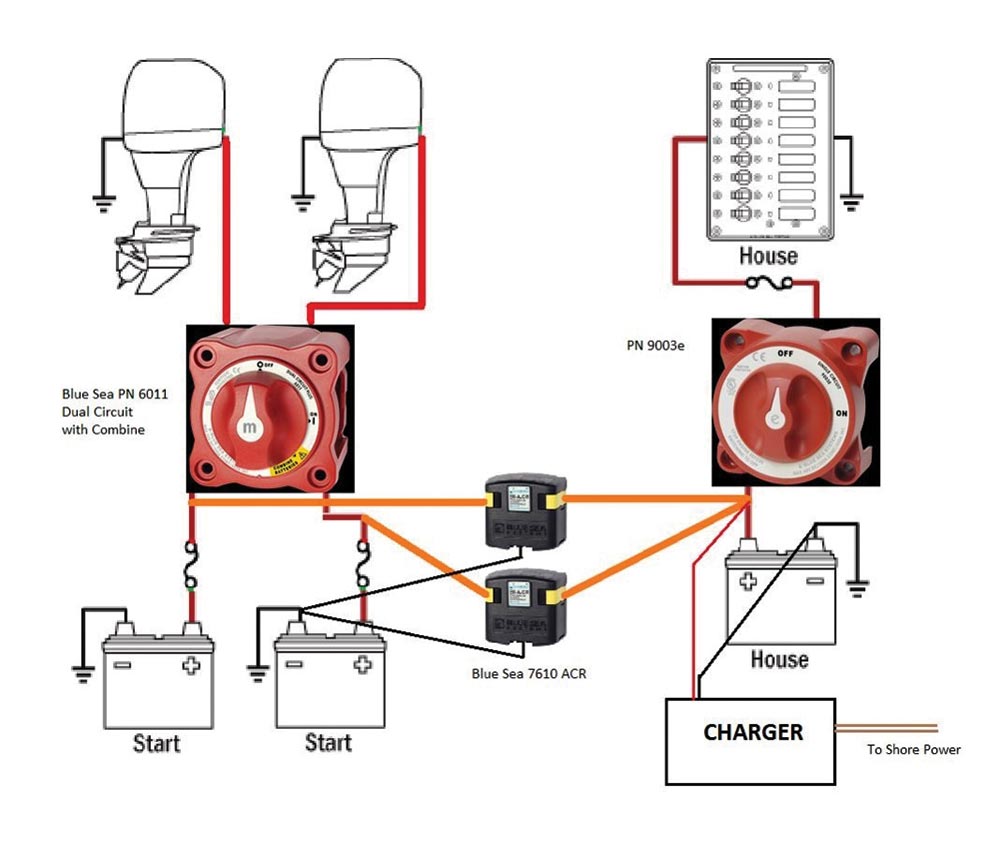
Battery Switches and Isolators: I have been a practitioner of the foolproof manual battery isolator circuit for decades. I employ the two battery switch (one engine) or four-switch (two engines) approach. To implement the one engine/two battery/two switch system, it is required that you add a simple On/Off battery switch to a standard 4-way switch. Attach the + cable from the starting battery to the “1” feeder on the 4-way switch. Attach the + cable from the house battery to the single feeder on the On/Off switch. Then run a short battery cable from the feeder lug on the On/Off switch to the “2” feeder on the 4-way switch. To complete this setup, attach the + feed from your engine’s wiring harness and keyswitch to the common output lug on the 4-way switch and the + lead(s) from your accessory/electronics panel to the common output lug on the On/Off switch.
To operate the system, follow these simple steps:
- Turn On/Off switch to the “on” position and start your electronics
- Turn 4-way switch to the #1 position and start your engine
- Turn 4-way switch to the “Both” position to charge both batteries when the boat is running
- When drifting for long periods with the engine off, turn 4-way switch to the “off” position
- To restart engine, refer to steps 2 and 3
- At the end of the day, turn both switches “off” and all power is cut-off to engine and electronics
That’s it, it is as simple as that and you control your own destiny with switches that actually turn everything on and off on demand and prevent unwanted power surges that can spike and potentially harm your electronics. In a pinch, you can also use your house battery to start your engine and also employ your cranking battery to run your electronics (for a short time, depending on its rating). It’s simply a function of flipping the right switches.
If you prefer the electronic path to recharging the batteries that are in need, Blue Sea Systems makes a very affordable product that makes this a snap to install on your boat. Their Starting Isolation Automatic Charging Relay (ACR) automatically combines battery banks during the charging cycle and isolates them while discharging, plus protects sensitive electronics by temporary isolation of house loads from engine circuit during engine cranking. The ACR allows two battery banks to be connected so that they can share the output of a single charge source, allowing the user to charge more battery banks than the number of charging outputs. For example, an ACR can be used with a single-output charger, resulting in a simpler system at lower cost than a dual-output charger. They use a relay combined with a circuit that senses when a charging source is being applied to either battery. If there is a charge present on either battery, indicated by a high enough voltage, the ACR will combine the batteries.
For anglers with banks of 24v or 36v trolling motor batteries, having a dedicated onboard charger that will replenish the expended deep cycle batteries after every deep discharge back at dockside or in the driveway will prolong their lifespan and it’s as simple as just plug and play. Many of the better units have built in protective circuitry to ensure the optimum charging rates without cooking off your electrolyte.
There’s plenty more to talk about regarding your marine batteries, but we are running out of time and space. Perhaps we will be able to address wiring batteries in series and parallel, along with some battery maintenance tips in a future article.

